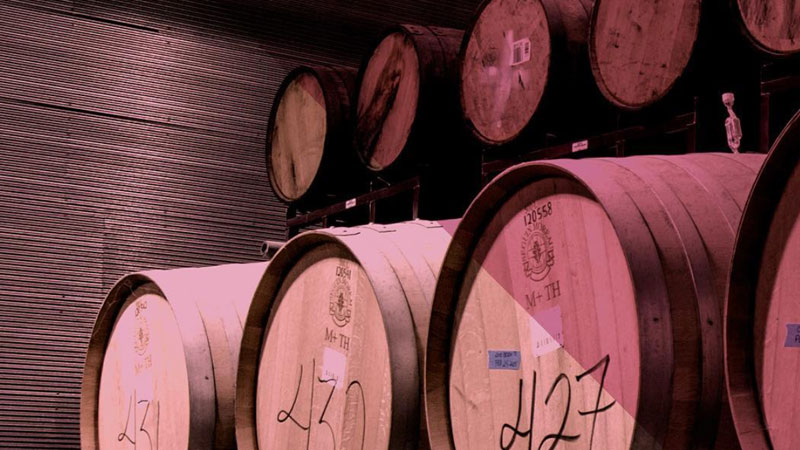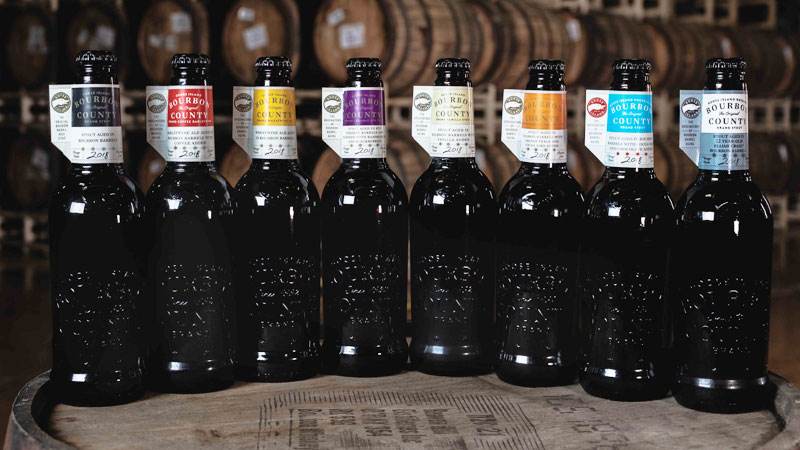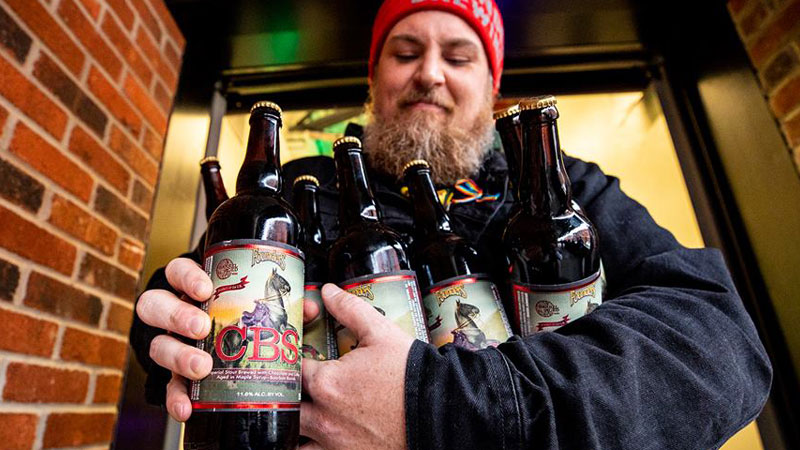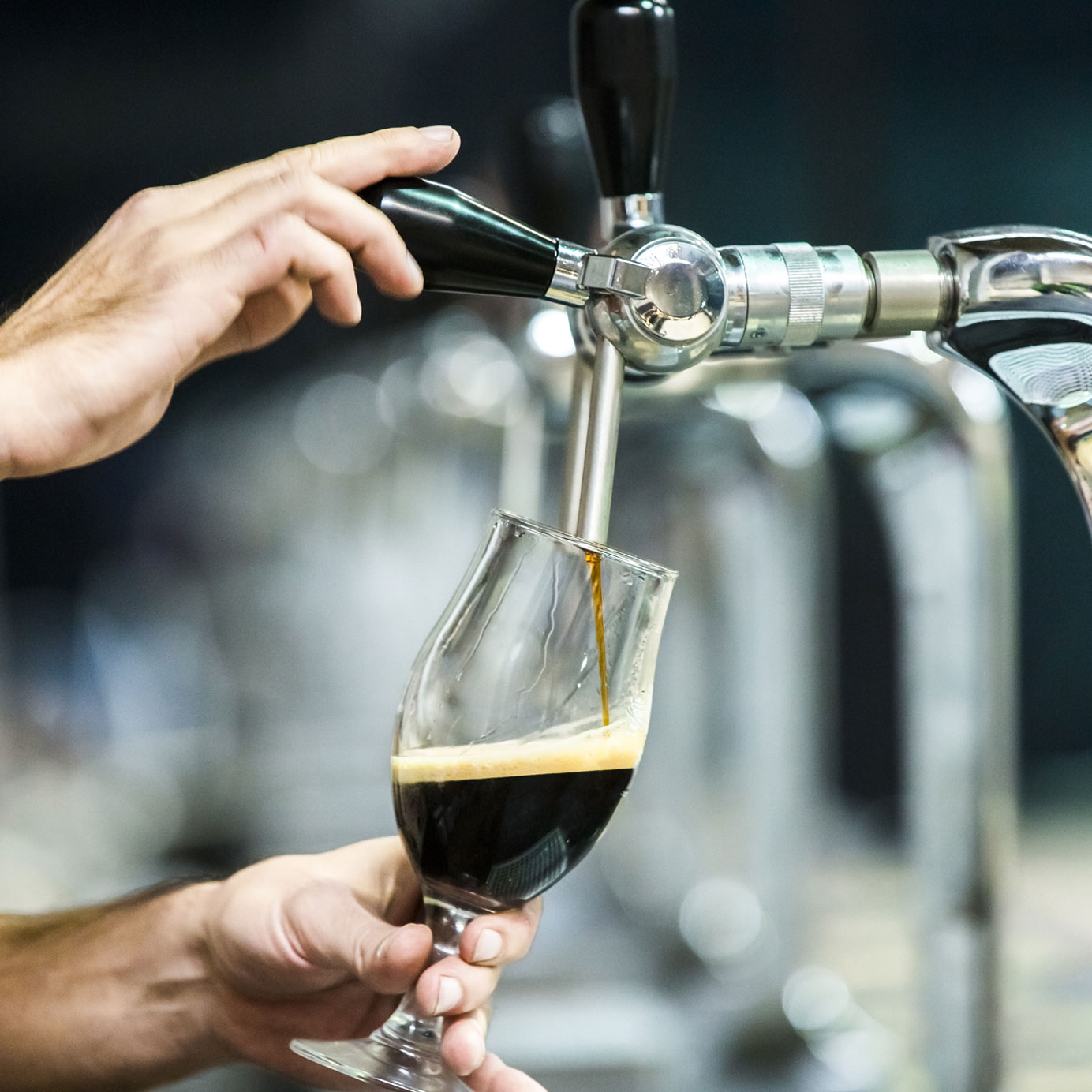It’s officially #stoutseason. For some, that may mean simply shifting gears from session IPAs to darker brews. For others, it entails a crowded calendar of special events celebrating the release of sticky, sludgy, boozy barrel-aged beers. These coveted creations cost double, and sometimes even 10 times the amount of an ordinary stout.
The elevated price tags are, in some ways, part of the appeal. Last weekend, thousands attended the 16th annual Festival of Wood and Barrel-Aged Beers (FOBAB) in Chicago, where hundreds of breweries show off their rarest barrel-aged brews. Consumer tickets start at $85.
November also marks the annual release of Founders Canadian Breakfast Stout ($25 for a 750-milliliter bottle) on Nov. 1. Ten days later comes Goose Island’s annual Prop Day, when the brewery releases special bottles from the famous Bourbon County Brand series at the Fulton Street brewery in Chicago. Tickets are awarded via a lottery drawing, and winners are chosen a month in advance. The chosen ones have the privilege of paying $30 for a ticket, which then grants them ability to purchase a bundle of beers for $70.
The nationwide release of Bourbon County stouts comes every year on Black Friday, the day after Thanksgiving. Beers start at $10 each. A few weeks later, on Dec. 15, Toppling Goliath superfans can cash in their $100 tickets to take home a 12-ounce bottle of Kentucky Brunch Brand Stout (KBBS).
Boozy, barrel-aged stouts are now a major calling card and revenue driver for breweries across the country. What makes these beers so expensive is, partly, the painstaking process in which they are made. It’s more than that, though. The success of sticker-shock stouts is a result of branding, the economics of scarcity, and a heavy helping of FOMO.
Are these beers worth their steep price tags? As with stouts themselves, the answer is hardly clear.

Casks, Costs, and Coddling
Special-release stouts admittedly seem like a product of contemporary one-upmanship and Instagram humblebrags, but their origins date back to the mid-1990s, when Goose Island debuted its Bourbon County Brand Stout (BCBS). In 2003, Founders followed suit with its Kentucky Breakfast Stout (KBS), a bourbon-barrel-aged chocolate coffee stout. FiftyFifty Brewing launched its Eclipse series in 2007, and Toppling Goliath debuted KBBS in 2012.
Barrel-aged beers like Bourbon County are significantly more expensive to create than “normal” stouts or other, non-barrel-aged beers. They often require at least double the amount of raw material, such as grains and hops, and so “costs do add up,” Bill Savage, Goose Island lead brewer, barrel program, says.
In his book “Barrel-Aged Stouts and Selling Out,” author Josh Noel writes that Goose Island’s Honker’s Ale uses about 550 pounds of malt. A typical imperial stout requires approximately 800 pounds, and BCBS necessitates more than 1,000 pounds of malt.
Casks are also costly, especially in recent years, Savage says. By his estimation, three or four years ago, “the bourbon boom really started taking off, and aged spirit casks were in short supply,” he says.
Today, bourbon barrels sell “in the ballpark of $150 per cask,” according to Savage, and the Bourbon County lineup requires “several thousand” of them. Savage is unable to give exact numbers, but this easily adds up to hundreds of thousands of dollars to produce BCBS. Compare this to a beer like Honkers Ale, which ferments and conditions in stainless steel tanks for up to two weeks.
Aging is also a pricey operation, requiring time, space, and personnel. At Goose Island, Savage leads a team of five — soon to be six — barrel program brewers who work year-round on barrel-aged beers like Bourbon County, which ages for at least eight months.

Hype Machine
Barrel-aged stout enthusiasts are willing to spend considerable time and money acquiring the rarest and highest-rated special releases. The culture surrounding such releases inspires beer reviews, bottle shares, cross-country trades, and Reddit threads.
Chauncey Jackson, a beer reviewer in Northern California, often features sought-after stouts on his YouTube channel, Allthingsbeer 510. Analytics allow him to break down what beer reviews are most popular among his audience. While Founders’ KBS and CBS are no longer “what they were as far as taste, hype, and trade value,” according to Jackson, Goose Island’s Bourbon County Brand Stouts are “some of my most commented and most watched reviews.”
This is especially notable given the heated politics surrounding beer ownership. Since 2011, Goose Island has been wholly owned by Anheuser-Busch InBev, arguably the craft beer world’s most rage-inducing supervillain. Additionally, Goose Island recalled several Bourbon County Brand Stouts in 2016.
Founders is no stranger to controversy, either. The Grand Rapids, Mich.-based brewery sold a minority stake of its business to Spanish brewer Mahou-San Miguel in 2014, after which many turned against the brewery on principle. Others feel that Founders is selling more KBS and CBS than in previous years, thus making it less desirable.
Availability (or lack thereof) is key to these beers’ desirability. “The FiftyFifty Brewing Eclipse beers are stupid expensive for a beer that no one seems to care about anymore,” Dan Lamonaca, owner of Beer Karma bottle shop and tasting counter in Brooklyn, N.Y., says. “I have a case of it from last year that I maybe sold one bottle of. It’s a beer that at one point was probably the vanguard of being a thick, rich, imperial stout, and now it’s a beer that’s run-of-the-mill. People pass it up because it’s no longer a luxury item.”

Is It Worth It?
Jackson also receives requests to review barrel-aged beers from Bottle Logic, Fremont Brewing, Prairie Artisan Ales, Side Project, and Toppling Goliath. This is in part because lots of people want but can’t have these beers; but it’s also because these beers have major resale value. Traders want to protect their investments.
“On the secondary market, [barrel-aged beers from these breweries] can go anywhere from $80 to $300 a bottle,” Jackson writes in an email.
Lamonaca says that people are “spending several hundred dollars on the secondary market. That just doesn’t make sense to me.”
Lamonaca adds that, earlier this month, many of his regular clients inquired about Founders’ CBS, which they’d seen around NYC priced between $30 and $35. “‘Is it worth it? Should I buy it?’” they asked him. The answer is nuanced, he says.
“I had some — it was really good — if you really like maple bourbon barrel-aged stuff you’re going to love this beer,” he says. But everyone has their limits. “If you start seeing it for $40 bottle, no; and if you’ve got to break your back trading for it, don’t.”
There’s also the FOMO element of “drinking something that the average person isn’t going to get their hands on,” Lamonaca says. “Is it better than everything else? Probably. Is it five, six, seven, or eight times better from a value perspective? No way. But you’re going to have something [no one else has], and that’s half of the excitement of it.”
Of course, genuinely enjoying the fanfare that surrounds a rare brew is a valid draw. You can’t buy happiness, after all, but you can get pretty close with the right bottle or event. For many specialty stout enthusiasts, attending release days and facilitating trades ignites an unparalleled sense of togetherness.
“It’s about the people you meet rather than necessarily about the beer,” Savage says. “Enthusiasm for the industry, even though it’s changed and morphed and continues to over the years, I think that’s kind of the cool part.”
‘It Is Up to the Public’
Finding your people is priceless. That said, it’s hard not to feel slightly cynical when analyzing a market this inflated. Pricing a stout so high most beer drinkers won’t buy it is “an example of breweries taking advantage of the market,” Lamonaca says. “They’re doing it because people are going to show up, and they’re going to buy it.”
In other words, brewers price these stouts far above other beers because they are expensive to produce, but also because the market can sustain it. If no one were willing to spend $100 on one beer, Toppling Goliath would stop releasing beers that cost that much.
Ultimately, beauty is in the eye of the beerholder.
“If you have the money, why not?” Jackson writes. “People need to get over how things used to be… Brewers spend time and a lot of money to give fans great beer. If the brewery wants to charge $100 for a beer, then do so. It is up to the public if they want to buy or not.”
For the right barrel-aged stout, Jackson writes, “I’m willing to trade half my cellar.”
